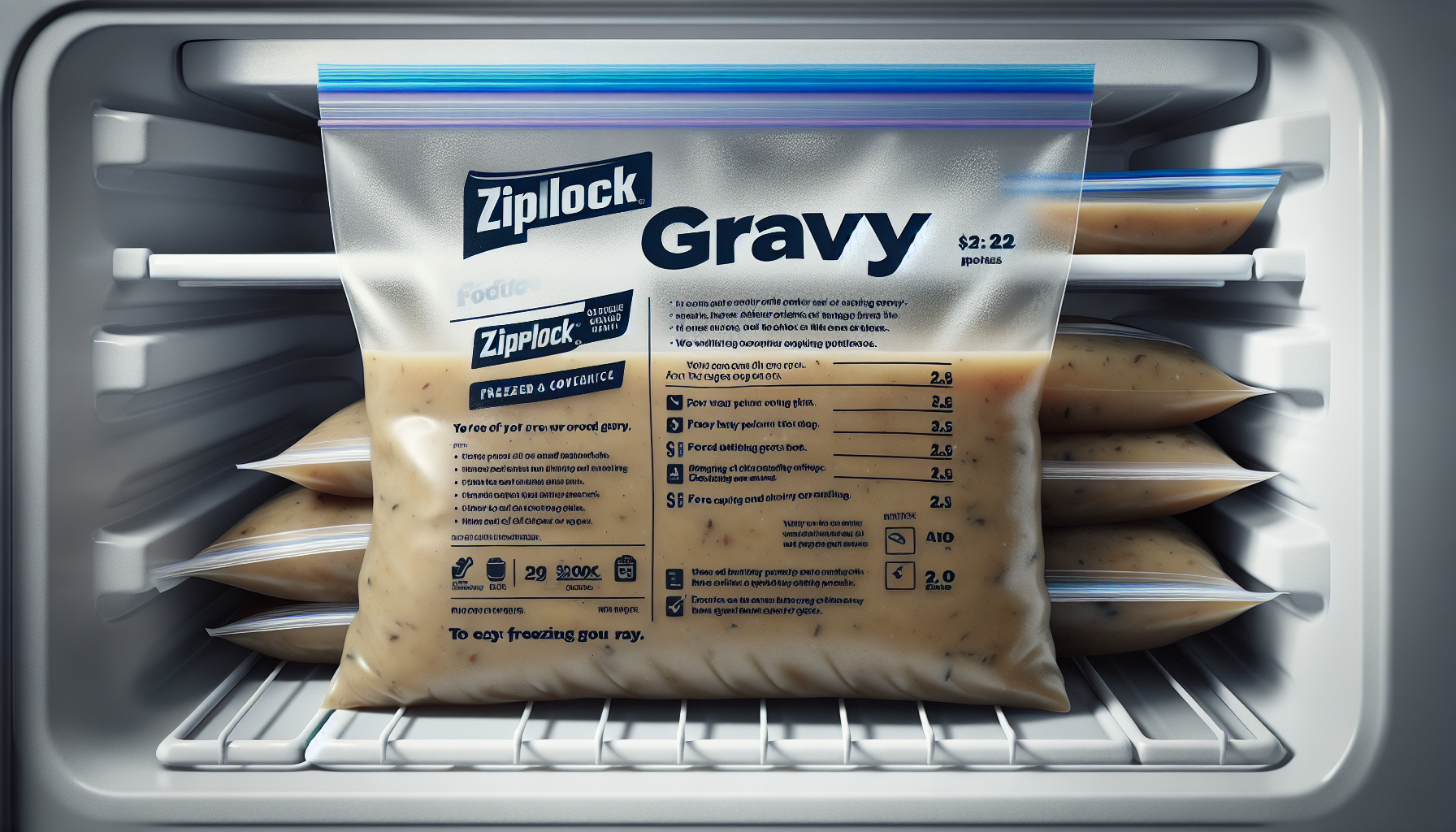So you’ve made a big batch of delicious homemade gravy, but you’re not going to use it all right away. Don’t worry, freezing gravy is a fantastic way to preserve it for future meals. Whether you’re preparing for a holiday feast or simply want to have a tasty sauce on hand whenever you need it, this article will guide you through the simple steps of freezing gravy. From preparing it for freezing to the best storage methods, we’ve got you covered. Say goodbye to wasted gravy and hello to convenient and delicious meals anytime you want!
Preparation
Before freezing your gravy, there are a few important steps to take to ensure the best results.
Cooling the Gravy
First, allow your gravy to cool completely before freezing. This will prevent condensation from forming inside the container and potentially affecting the quality of the gravy. Simply let the gravy sit at room temperature until it reaches room temperature, then move on to the next step.
Choosing the Right Container
Choosing the right container is crucial when freezing gravy. It’s best to use containers that are specifically designed for the freezer, as they are made with materials that can withstand low temperatures without cracking or breaking. These containers are usually made of BPA-free plastic or silicone, both of which are safe for freezing. Avoid using glass containers, as they may shatter when exposed to extreme temperatures.
Freezing Methods
Once your gravy is cooled, it’s time to choose the freezing method that works best for you. Here are three popular options:
Ziplock Bags
Ziplock bags are a convenient and space-saving option for freezing gravy. To use this method, simply pour the cooled gravy into a freezer-safe ziplock bag, leaving some room at the top for expansion. Seal the bag tightly, ensuring there are no leaks, and lay it flat in the freezer. This method allows for easy portioning and takes up minimal space.
Plastic Freezer Containers
Plastic freezer containers are another great option for freezing gravy. These containers come in various sizes, allowing you to choose the one that best suits your needs. Fill the container with the cooled gravy, leaving about an inch of space at the top to account for expansion. Secure the lid tightly and place it in the freezer. Plastic freezer containers are durable and stackable, making them a practical choice.
Silicone Ice Cube Trays
If you prefer smaller portions of gravy, using silicone ice cube trays is a fantastic option. Simply pour the gravy into the individual compartments of the tray, making sure not to overflow. Place the tray on a flat surface in the freezer and allow the gravy to freeze completely. Once frozen, remove the gravy cubes from the tray and transfer them to a freezer-safe bag or container. This method is ideal for easily portioning out smaller servings of gravy.
Portioning and Storing
After freezing your gravy, it’s important to portion and store it properly to maintain its quality.
Dividing into Serving Portions
If you froze your gravy in a larger container, you may need to divide it into smaller serving portions. This will allow you to thaw only the amount you need without having to defrost the entire container. Use a knife or spoon to separate the frozen gravy into individual servings, whether it be in slices or cubes.
Labeling and Dating
To keep track of your frozen gravy, it’s essential to label and date each container or bag. Use a permanent marker to write the contents and date of freezing on the packaging. This will help you keep track of the gravy’s freshness and ensure you use the oldest portions first. Organization is key when it comes to freezer storage.
Storing in the Freezer
Once your gravy is portioned and labeled, place the containers or bags back in the freezer. Make sure they are stored in an organized manner, with the oldest portions in front for easy access. If you’re using a ziplock bag, you may want to place it on a baking sheet or tray to prevent any potential leaks from affecting other items in the freezer.
Thawing and Reheating
When the time comes to enjoy your frozen gravy, there are a few methods to safely thaw and reheat it.
Refrigerator Thawing
The safest and most recommended method for thawing frozen gravy is in the refrigerator. Simply transfer the frozen gravy from the freezer to the refrigerator the night before you plan to use it. Allow it to thaw slowly in the fridge, ensuring it stays at a safe temperature to prevent bacterial growth. This method may take several hours or overnight, depending on the amount of gravy and the thickness.
Water Bath Thawing
If you’re in a hurry and need to thaw your frozen gravy more quickly, a water bath can be used. Fill a large bowl or sink with cold water and submerge the container or bag of frozen gravy. Make sure the packaging is tightly sealed to prevent any water from seeping in. Change the water every 30 minutes to keep it cold. This method should thaw the gravy within a couple of hours, but it’s important to use the gravy immediately after thawing.
Microwave Thawing
Microwave thawing is the fastest method but should be used with caution. If you choose to thaw your gravy in the microwave, make sure to use a microwave-safe container or bag and follow the manufacturer’s instructions for defrosting. Microwave thawing can be uneven and may cause some parts of the gravy to become hot before others are fully thawed. Be sure to stir the gravy well after microwaving to distribute the heat evenly.
Reheating on the Stove
Once your frozen gravy is thawed, you can reheat it on the stove for serving. Pour the thawed gravy into a saucepan and heat over medium-low heat, stirring continuously until it reaches your desired temperature. This method allows you to control the heat and ensure even reheating without risking overcooking or burning the gravy.
Reheating in the Microwave
If you prefer using the microwave for reheating, transfer the thawed gravy to a microwave-safe container or bowl. Heat it in short intervals, stirring in between, until it reaches the desired temperature. Be mindful not to overheat the gravy, as it could become too hot and lose its desired consistency.
Tips and Tricks
To achieve the best frozen gravy results, here are some helpful tips and tricks:
Use Quality Ingredients
When making gravy intended for freezing, use fresh and high-quality ingredients for the best flavor and texture. This will ensure that your gravy freezes well and tastes delicious when reheated.
Remove Excess Fat
If your gravy has a significant amount of fat floating on the surface, consider removing some of it before freezing. Excess fat can affect the overall texture and flavor of the gravy. You can use a spoon or ladle to skim off the fat or use a fat separator to make the process easier.
Add Thickener if Necessary
Gravy can sometimes become thinner when frozen and reheated. If you find that your thawed gravy is too thin, you can add a thickening agent such as cornstarch or flour. Mix the thickener with cold water or broth and whisk it into the reheated gravy over medium heat until it reaches the desired thickness.
Adjust Seasoning
After thawing and reheating, taste your gravy and adjust the seasoning if needed. Freezing can sometimes dull the flavors, so adding a touch of salt, pepper, or your favorite herbs and spices can help enhance the taste of the reheated gravy.
Consider Adding a Bit of Liquid
If you find that your gravy has become too thick after freezing and reheating, you can add a small amount of liquid such as broth or water to thin it out. Add the liquid gradually, stirring continuously until you reach the desired consistency.
Frequently Asked Questions
Can I freeze gravy made with flour?
Yes, you can freeze gravy made with flour. However, it’s important to note that the consistency of the gravy may change slightly upon thawing and reheating. To address this, you can add a thickening agent after reheating if necessary.
How long can I keep frozen gravy?
Frozen gravy can be kept for up to three months in the freezer. Be sure to label and date your containers to ensure you use the oldest portions first.
Can I freeze gravy with meat in it?
Yes, you can freeze gravy with meat in it. However, the texture of the meat may change slightly upon thawing and reheating. Keep this in mind and adjust your expectations accordingly.
Can I freeze homemade turkey gravy?
Absolutely! Homemade turkey gravy can be frozen using the same methods described above. Just make sure it has cooled completely before freezing and follow the portioning and storing guidelines to maintain its quality.
Can I freeze vegetarian gravy?
Yes, vegetarian gravy can also be frozen. Whether it’s made with vegetable broth or meat substitutes, the freezing and reheating methods remain the same. Enjoy your vegetarian gravy whenever you’re in the mood for a delicious and convenient meal!
Conclusion
Freezing gravy is a fantastic way to extend its shelf life and have it readily available for future meals. By following the proper preparation, freezing, and thawing techniques, you can maintain the quality and flavor of your gravy. Experiment with different freezing methods and portion sizes to find what works best for your needs. With these tips and tricks, you’ll be able to freeze, store, and enjoy your favorite gravy recipes with ease. Happy freezing!

